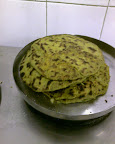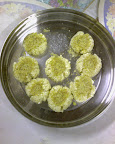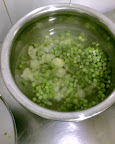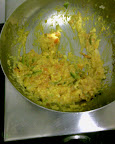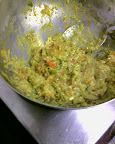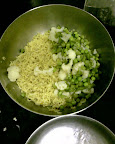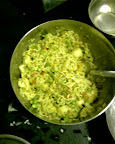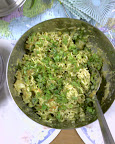- Masala: Any Masala. I used Pav Bhaji Masala.
- Bhaji: A mixture of vegetables. I used cabbage, cauliflower, potatoes and onions.
- Parantha: A covering of wheat flour knead into a dough, and flattened into a roti like shape.
Total Time: 1 hour 30 minutes
Serves: 8-9
Ingredients:
- Pre-knead dough for making about 8 chapatis
- 1 large potato
- 1/4 cabbage, thinly sliced
- 1 large onion, cut into fine pieces
- 1/3 cauliflower
- Salt
- 2 tsp Pav Bhaji masala
- 2 Pinch Asafoetida(Hing)
- 1 tsp Ginger paste
- 2 garlic cloves, cut into fine pieces
- 1 1/2 Tbsp Butter(salted/unsalted)
- 1/3 tsp Turmeric powder(Haldi)
- 9 Tbsp Ghee or Vegetable oil(approx.)
Special equipment required:
- A potato masher
Procedure:
- Make about 8-9 small balls from the pre-knead chapati dough. You may optionally colour and flavour it by adding haldi(or pudina[mint] paste) and salt -- to taste.
- Roll these into chapatis. Keep aside.
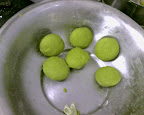
- Boil the potato and all the vegetables(except the onion). You may add some salt in the water so that the vegetables soften faster.
- Once boiled, drain out most of the water. We will need some(about 1/4 cup) to cook the vegetables.
- Peel the potato.
- Heat butter in a pan, and add Hing to it.
- Saute the onions till they are light golden in colour.
- Add the ginger paste and garlic pieces. Mix well for a few seconds.
- Add the vegetables, and add the pav bhaji masala, haldi and salt to taste.
- Cook for a few minutes till all the water has evaporated and the vegetables are dry. Keep stirring or the vegetables will get burnt.
- Now use the masher and mash all the vegetables in the mixture above.
- Let this mixture cool for a while under the fan. As the mixture cools, it will also thicken a bit. This will help us in used it as a filling for the paranthas.
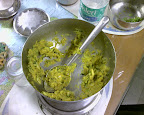
- Now use this as a filling for the paranthas, and again roll them into slightly thick paranthas.
- To fry, heat a thick tawa(roti pan) till it is completely and evenly heated up. Spread a little bit of ghee on it evenly.
- Reduce the flame to medium-low.
- Now spread the parantha on it, and sprinkle the sides with ghee. This should be about 1/4 tsp.
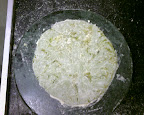
- When it feels done, use around 1/4 tsp ghee to coat the top side.
- Over-turn the parantha and sprinkle this side too with 1/4 tsp ghee.
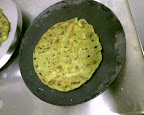
- Use the rest of the ghee to cover the now top-side with ghee./li>
- When it is done, over-turn once again, check for doneness on both sides, and serve.
